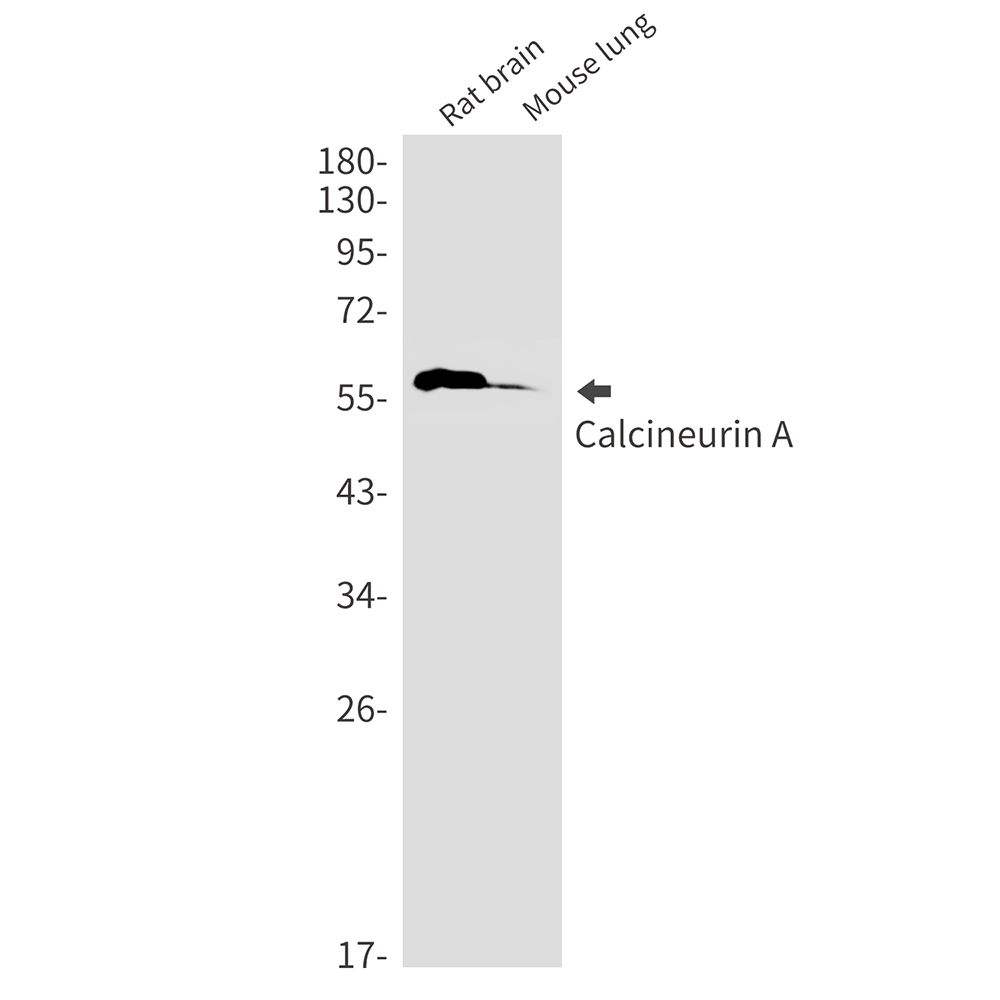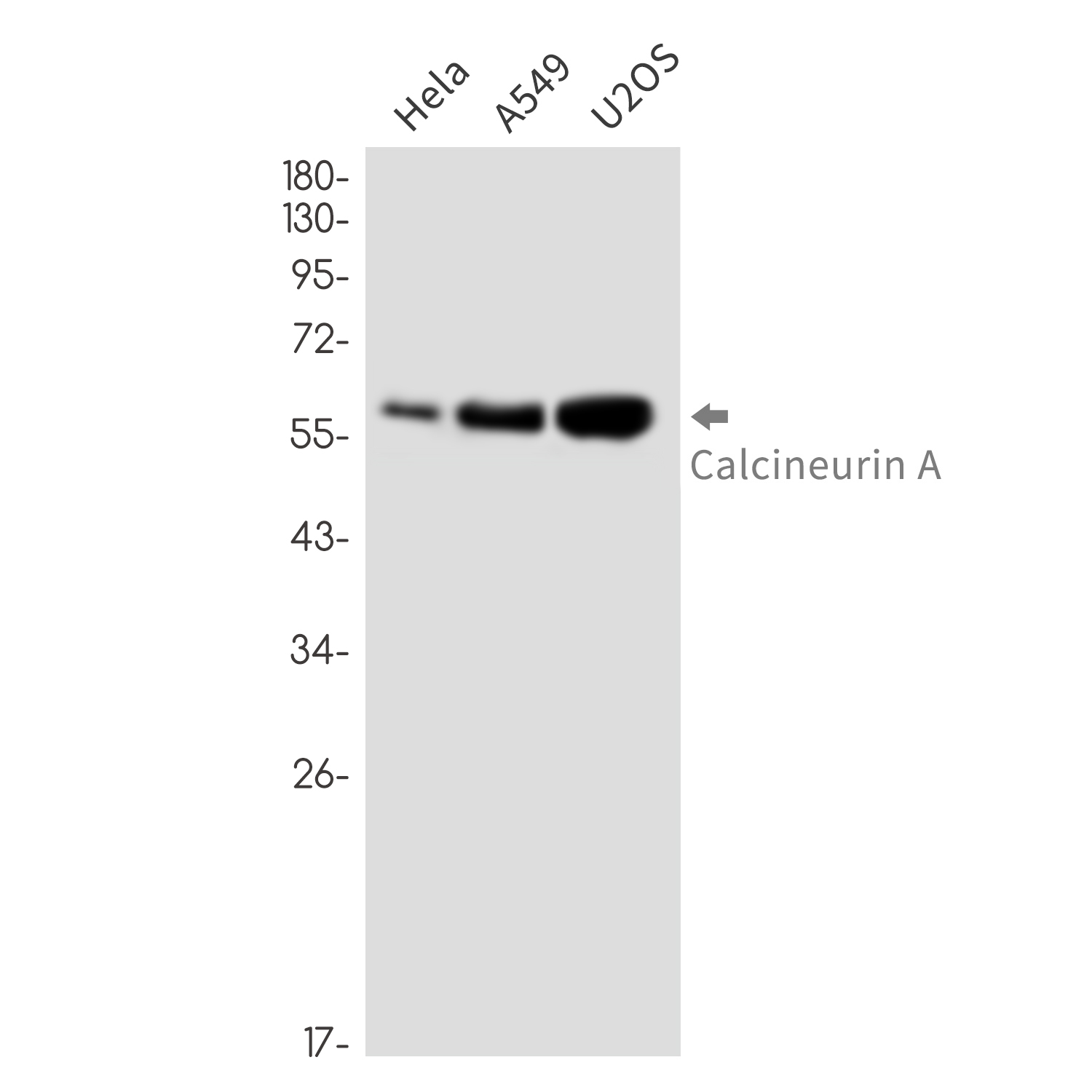Calcineurin A Rabbit mAb
- 产品详情
- 实验流程
Application
| WB, IP |
|---|---|
| Primary Accession | Q08209 |
| Reactivity | Human, Mouse, Rat |
| Host | Rabbit |
| Clonality | Monoclonal Antibody |
| Calculated MW | 58688 Da |
| Gene ID | 5530 |
|---|---|
| Other Names | PPP3CA |
| Dilution | WB~~1/500-1/1000 IP~~1/20 |
| Format | 50mM Tris-Glycine(pH 7.4), 0.15M NaCl, 40%Glycerol, 0.01% sodium azide and 0.05% BSA. |
| Storage | Store at 4°C short term. Aliquot and store at -20°C long term. Avoid freeze/thaw cycles. |
| Name | PPP3CA (HGNC:9314) |
|---|---|
| Synonyms | CALNA, CNA |
| Function | Calcium-dependent, calmodulin-stimulated protein phosphatase which plays an essential role in the transduction of intracellular Ca(2+)-mediated signals (PubMed:15671020, PubMed:18838687, PubMed:19154138, PubMed:23468591, PubMed:30254215). Many of the substrates contain a PxIxIT motif and/or a LxVP motif (PubMed:17498738, PubMed:17502104, PubMed:22343722, PubMed:23468591, PubMed:27974827). In response to increased Ca(2+) levels, dephosphorylates and activates phosphatase SSH1 which results in cofilin dephosphorylation (PubMed:15671020). In response to increased Ca(2+) levels following mitochondrial depolarization, dephosphorylates DNM1L inducing DNM1L translocation to the mitochondrion (PubMed:18838687). Positively regulates the CACNA1B/CAV2.2-mediated Ca(2+) release probability at hippocampal neuronal soma and synaptic terminals (By similarity). Dephosphorylates heat shock protein HSPB1 (By similarity). Dephosphorylates and activates transcription factor NFATC1 (PubMed:19154138). In response to increased Ca(2+) levels, regulates NFAT-mediated transcription probably by dephosphorylating NFAT and promoting its nuclear translocation (PubMed:26248042). Dephosphorylates and inactivates transcription factor ELK1 (PubMed:19154138). Dephosphorylates DARPP32 (PubMed:19154138). May dephosphorylate CRTC2 at 'Ser-171' resulting in CRTC2 dissociation from 14-3-3 proteins (PubMed:30611118). Dephosphorylates transcription factor TFEB at 'Ser- 211' following Coxsackievirus B3 infection, promoting nuclear translocation (PubMed:33691586). Required for postnatal development of the nephrogenic zone and superficial glomeruli in the kidneys, cell cycle homeostasis in the nephrogenic zone, and ultimately normal kidney function (By similarity). Plays a role in intracellular AQP2 processing and localization to the apical membrane in the kidney, may thereby be required for efficient kidney filtration (By similarity). Required for secretion of salivary enzymes amylase, peroxidase, lysozyme and sialic acid via formation of secretory vesicles in the submandibular glands (By similarity). Required for calcineurin activity and homosynaptic depotentiation in the hippocampus (By similarity). Required for normal differentiation and survival of keratinocytes and therefore required for epidermis superstructure formation (By similarity). Positively regulates osteoblastic bone formation, via promotion of osteoblast differentiation (By similarity). Positively regulates osteoclast differentiation, potentially via NFATC1 signaling (By similarity). May play a role in skeletal muscle fiber type specification, potentially via NFATC1 signaling (By similarity). Negatively regulates MAP3K14/NIK signaling via inhibition of nuclear translocation of the transcription factors RELA and RELB (By similarity). Required for antigen-specific T- cell proliferation response (By similarity). Dephosphorylates KLHL3, promoting the interaction between KLHL3 and WNK4 and subsequent degradation of WNK4 (PubMed:30718414). Negatively regulates SLC9A1 activity (PubMed:31375679). |
| Cellular Location | Cytoplasm. Cell membrane; Peripheral membrane protein. Cell membrane, sarcolemma {ECO:0000250|UniProtKB:P63329}. Cytoplasm, myofibril, sarcomere, Z line {ECO:0000250|UniProtKB:P63329}. Cell projection, dendritic spine. Note=Colocalizes with ACTN1 and MYOZ2 at the Z line in heart and skeletal muscle (By similarity). Recruited to the cell membrane by scaffold protein AKAP5 following L-type Ca(2+)-channel activation (PubMed:22343722) {ECO:0000250|UniProtKB:P63329, ECO:0000269|PubMed:22343722} |
| Tissue Location | Expressed in keratinocytes (at protein level) (PubMed:29043977). Expressed in lymphoblasts (at protein level) (PubMed:30254215). |
Research Areas
For Research Use Only. Not For Use In Diagnostic Procedures.
Application Protocols
Provided below are standard protocols that you may find useful for product applications.
终于等到您。ABCEPTA(百远生物)抗体产品。
点击下方“我要评价 ”按钮提交您的反馈信息,您的反馈和评价是我们最宝贵的财富之一,
我们将在1-3个工作日内处理您的反馈信息。
如有疑问,联系:0512-88856768 tech-china@abcepta.com.
¥ 1,500.00
Cat# AP76416























 癌症的基本特征包括细胞增殖、血管生成、迁移、凋亡逃避机制和细胞永生等。找到癌症发生过程中这些通路的关键标记物和对应的抗体用于检测至关重要。
癌症的基本特征包括细胞增殖、血管生成、迁移、凋亡逃避机制和细胞永生等。找到癌症发生过程中这些通路的关键标记物和对应的抗体用于检测至关重要。 为您推荐一个泛素化位点预测神器——泛素化分析工具,可以为您的蛋白的泛素化位点作出预测和评分。
为您推荐一个泛素化位点预测神器——泛素化分析工具,可以为您的蛋白的泛素化位点作出预测和评分。 细胞自噬受体图形绘图工具为你的蛋白的细胞受体结合位点作出预测和评分,识别结合到自噬通路中的蛋白是非常重要的,便于让我们理解自噬在正常生理、病理过程中的作用,如发育、细胞分化、神经退化性疾病、压力条件下、感染和癌症。
细胞自噬受体图形绘图工具为你的蛋白的细胞受体结合位点作出预测和评分,识别结合到自噬通路中的蛋白是非常重要的,便于让我们理解自噬在正常生理、病理过程中的作用,如发育、细胞分化、神经退化性疾病、压力条件下、感染和癌症。







